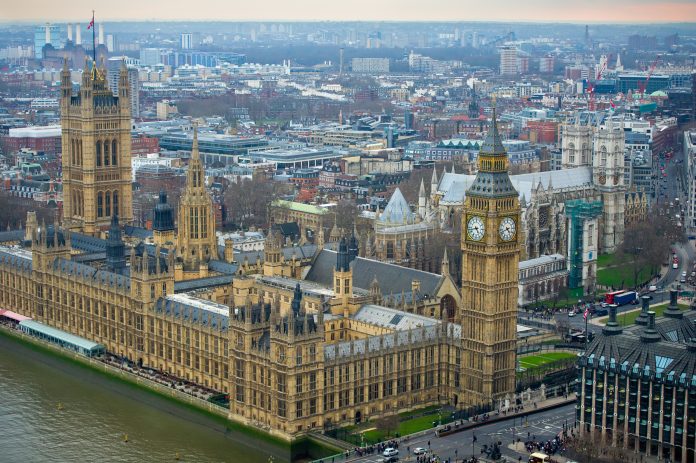Restoration of the Houses of Parliament has been delayed for decades, but advances in construction technology can help solve the challenges
Earlier this year, the Houses of Parliament experienced a dramatic burst water pipe that sent water pouring through the ceiling, drenching legislators in the chamber during an important debate. Not long before, an electrical fire started by a malfunctioning light set fire to the roof and caused significant damage internally and externally. The more worrying part was had it not been detected as early as it was, the situation could have been much more severe.
The Notre Dame fire this year served as a reminder that some of the most cherished buildings in Europe are also the most vulnerable. In the aftermath of the fire in France, multiple politicians spoke of the need to avoid a similar catastrophe in the UK. The Palace of Westminster, for example, caught fire an incredible 40 times between 2008 and 2012. It now has a fire safety team of four or five members patrolling the building on the lookout for flames to extinguish.
The Palace of Westminster Restoration and Renewal Programme
With over 1,100 rooms, including a hairdresser and a gym, and over 4,000 windows, many of which don’t open and close properly, the refurbishment project is no quick fix. The Palace of Westminster Restoration and Renewal Programme project is initially predicted to cost between £3bn and £5bn of tax-payers money and take at least six years to complete. However multiple reports, including one from the FT, have since reported that the project will most likely be delayed by “several years” which will likely push up the final cost as well.
The Palace of Westminster is a Grade 1 listed building. Since its construction in the mid-1800s, the building has remarkably undergone no major renovation works. This is most evident in the main chamber, where 650 MPs are currently asked to share 427 seats. Much worse than this though is the risk from the decay of the internal HVAC, the asbestos-lined air-ducts and the huge build-up of electrical cables currently hidden away from view. As it has never previously been possible to close Westminster, electricians have mostly only ever had time to install new cables, rather than take anything out. It’s left over 240 miles of cabling inside. In one room, for example, there is said to be over 3500 cables, a large amount that can’t be removed because it is impossible to identify what they do.
Additionally, the growing concerns of fires are then exasperated by the crumbling stonework, the large amounts of asbestos throughout the building, and the unreliable and potentially dangerous electrics, all of which would quickly exasperate the problem should a fire ever start.
Undoubtedly, the scale of this renovation means there will be several project teams working 24 hours a day over the course of several years. Some estimations suggest the building would need to close for 8 years for all the essential work to be completed, which seems unthinkable until you consider the other option is three or four decades of quite serious disruption with many of the chambers closed for years at a time. It’s understandable therefore why the can has been kicked down the road. No politician has been keen to announce billions of pounds of renovations to a building that, still remains in remarkably good condition from a distance at a time of austerity, despite the large amounts of scaffolding that have covered it in recent years. The delays to the project have increased the seriousness of the renovations though, which in turn requires more money and more time, with every year the renovations are delayed estimated to cost £100m in excess.
Using technology to restore the Palace of Westminster
While the delays to the project have been extensive, one bonus is they have also granted time for the technology in construction to catch up. Often described as a laggard when it comes to embracing technology, the construction sector has shown a remarkable willingness in recent years to embrace digitalisation and tackle its issues with productivity head-on. When dealing with one of the biggest renovations in the UK’s history, the construction management software that now exists could keep the costs of a project of this scale under control.
What difference does it make? When the Palace was rebuilt after the Great Fire of London it ran three times over budget. A similar scenario here would be astronomical in cost but not unusual. Worldwide, the average large construction project takes 20% longer to complete than planned and runs a staggering 80% over budget.
That’s why new project management have been designed, with a focus on tackling delays and increasing project efficiency, often by as much as 70%. These platforms keep all the appointments, documents, plans and tasks for a project on a fast and efficient platform that resembles a blueprint of the building. They offer a complete real estate life cycle that helps developers, planners, architects and construction contractors seamlessly communicate with each other, with easy ticketing that allows attributes such as pictures, voice memos and annotations of defects.
Avoiding cost defects in construction
Studies show that the cost of defects in construction can be in the range of 10-25% of the total production cost, with avoidable construction errors costing the UK construction industry around £21bn annually. Given the huge number of people that will be working on the project, the ability to identify and fix defects as and when they happen can stop problems and costs spiralling out of control. With these new systems, average users are reporting time savings of seven working hours per week on average, which is almost an entire day of work saved a week (roughly 18% of working time).
A survey we conducted among our users and average personnel costs found an average ROI of 900%. It’s figures such as these that demonstrate the difference that on the ground digitalisation can make, and how digital technologies can significantly impact on the productivity gap by maximising the ROI of infrastructure investment. Continued modernisation will improve long-term margins, lower delivery costs, and create greater predictability by de-risking on site delivery.
Ibrahim Iman
Co-founder
Twitter: @PlanRadarUK














